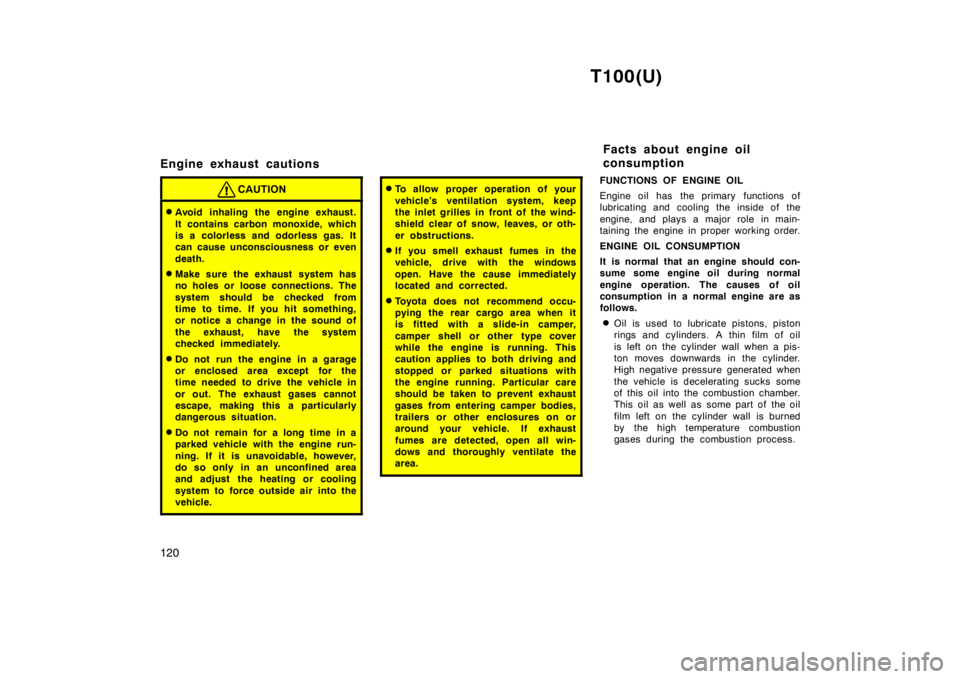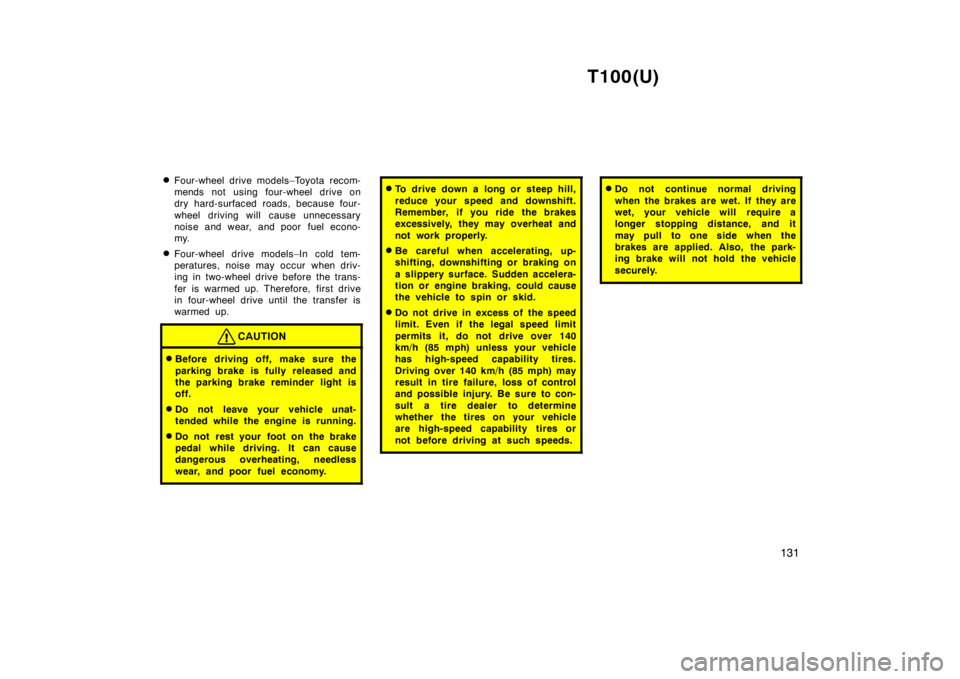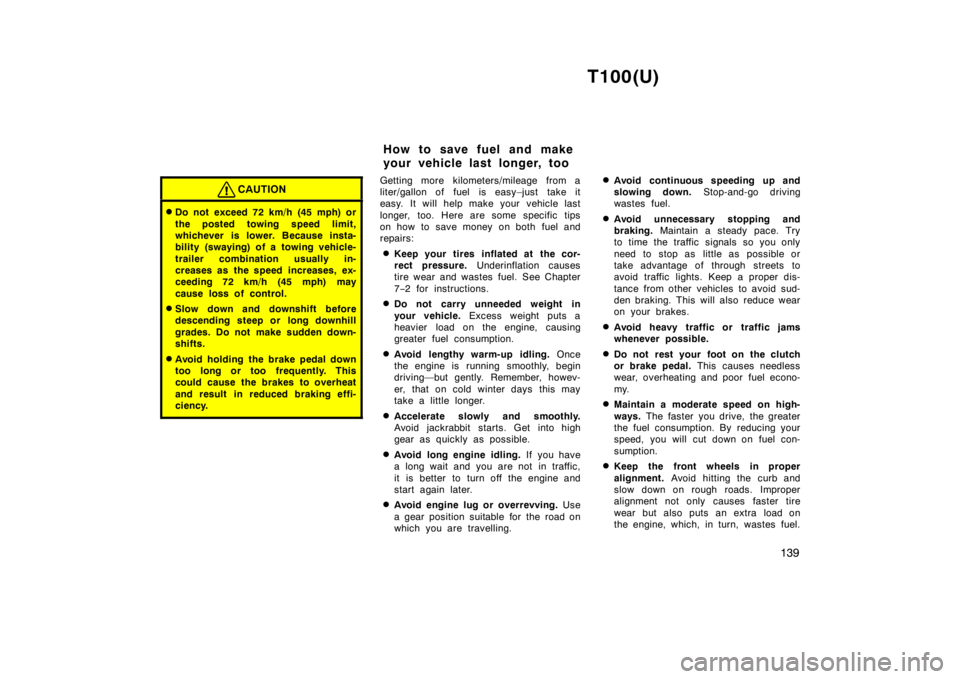1998 TOYOTA T100 heating
[x] Cancel search: heatingPage 68 of 214

T100(U)
68
Vehicles with cruise control–When the
cruise control is being used, even if you
downshift the transmission by turning off
the overdrive switch, engine braking will
not be applied because the cruise control
is not cancelled. For ways to decrease
the vehicle speed, see ”Cruise control” in
this chapter.
CAUTION
Be careful when downshifting on a
slippery surface. Abrupt shifting
could cause the vehicle to spin or
skid.
(c) Using ”2” and ”L” positions
The ”2” and ”L” positions are used for
strong engine braking as described pre-
viously.
With the selector lever in ”2” or ”L”, you
can start the vehicle in motion as with the
lever in ”D”.
With the selector lever in ”2”, the vehicle
will start in the first gear and automatical-
ly shift to the second gear.
With the selector lever in ”L”, the trans-
mission is engaged in the first gear.
NOTICE
�
Be careful not to overrev the en-
gine. Watch the tachometer to keep
engine rpm from going into the red
zone. The approxmate maximum al-
lowable speed for each position is
given below for your reference:
Two-wheel drive models—
”2” 100 km/h (62 mph)
”L” 55 km/h (34 mph)
Four-wheel drive models—
—Four-wheel drive control lever
in ”H2” and ”H4” ”2” 100 km/h (62 mph)
”L” 55 km/h (34 mph)
—Four-wheel drive control lever
in ”L4” ”2” 35 km/h (21 mph)
”L” 20 km/h (12 mph)
� Do not continue hill climbing for a
long time in the ”2” or ”L” posi-
tion. This may cause severe auto-
matic transmission damage from
overheating. To prevent such dam-
age, use ”D” position for hill climb-
ing or hard towing.
(d) Backing up
1. Bring the vehicle to a complete stop.
2. With the brake pedal held down with your foot, shift the selector lever to the
”R” position.
NOTICE
Never shift into reverse while the ve-
hicle is moving.
(e) Parking
1. Bring the vehicle to a complete stop.� Pull the parking brake lever up fully to
securely apply the parking brake.
� With the brake pedal pressed down,
shift the selector lever to the ”P” posi-
tion.
CAUTION
While the vehicle is moving, never
attempt to move the selector lever
into ”P” position under any circum-
stances. Serious mechanical damage
and loss of vehicle control may re-
sult.
Page 108 of 214

T100(U)
108
Heating
For best results, set controls to:
Fan speed —Any setting except ”OFF”
Temperature —Towards WA R M
(red zone)
Air intake —FRESH (outside air)
Air flow —FLOOR
Air conditioning —OFF
� For quick heating, select recirculated
air for a few minutes. To keep the
windows from fogging, select fresh af-
ter the vehicle interior has been
warmed.
� Press the ”A/C” button on for dehumidi-
fied heating.
� Choose floor/windshield air flow to heat
the vehicle interior while defrosting or
defogging the windshield. Air conditioning
For best results, set controls to:
Fan speed —Any setting except ”OFF”
Temperature —Towards COLD
(blue zone)
Air intake —FRESH (outside air)
Air flow —PA N E L
Air conditioning —ON�For quick cooling, move the air intake
selector to recirculate for a few min-
utes.
Ventilation
For best results, set controls to:
Fan speed —Any setting except ”OFF”
Temperature —Towards COLD
(blue zone)
Air intake —FRESH (outside air)
Air flow —PA N E L
Air conditioning —OFF
Defogging
The inside of the windshield
For best results, set controls to:
Fan speed —Any setting except ”OFF”
Temperature —Towards WARM
(red zone) to heat; COLD (blue zone) to
cool
Air intake —FRESH (outside air)
Air flow —WINDSHIELD
Vehicles with ”A/C” button—
Moving the air flow selector lever to the
windshield position turns on the defroster −
linked air conditioning. This is to clear up
the front view more quickly.
When the ”A/C” button is not pressed in,
moving the air flow selector lever to
another position turns off the air condition-
ing.
� On humid days, do not blow cold air
on the windshield—the difference be-
tween the outside and inside tempera-
tures could make the fogging worse.
Page 120 of 214

T100(U)
120
Engine exhaust cautions
CAUTION
�
Avoid inhaling the engine exhaust.
It contains carbon monoxide, which
is a colorless and odorless gas. It
can cause unconsciousness or even
death.
� Make sure the exhaust system has
no holes or loose connections. The
system should be checked from
time to time. If you hit something,
or notice a change in the sound of
the exhaust, have the system
checked immediately.
� Do not run the engine in a garage
or enclosed area except for the
time needed to drive the vehicle in
or out. The exhaust gases cannot
escape, making this a particularly
dangerous situation.
� Do not remain for a long time in a
parked vehicle with the engine run-
ning. If it is unavoidable, however,
do so only in an unconfined area
and adjust the heating or cooling
system to force outside air into the
vehicle.
�To allow proper operation of your
vehicle’s ventilation system, keep
the inlet grilles in front of the wind-
shield clear of snow, leaves, or oth-
er obstructions.
� If you smell exhaust fumes in the
vehicle, drive with the windows
open. Have the cause immediately
located and corrected.
� Toyota does not recommend occu-
pying the rear cargo area when it
is fitted with a slide-in camper,
camper shell or other type cover
while the engine is running. This
caution applies to both driving and
stopped or parked situations with
the engine running. Particular care
should be taken to prevent exhaust
gases from entering camper bodies,
trailers or other enclosures on or
around your vehicle. If exhaust
fumes are detected, open all win-
dows and thoroughly ventilate the
area.FUNCTIONS OF ENGINE OIL
Engine oil has the primary functions of
lubricating and cooling the inside of the
engine, and plays a major role in main-
taining the engine in proper working order.
ENGINE OIL CONSUMPTION
It is normal that an engine should con-
sume some engine oil during normal
engine operation. The causes of oil
consumption in a normal engine are as
follows.
� Oil is used to lubricate pistons, piston
rings and cylinders. A thin film of oil
is left on the cylinder wall when a pis-
ton moves downwards in the cylinder.
High negative pressure generated when
the vehicle is decelerating sucks some
of this oil into the combustion chamber.
This oil as well as some part of the oil
film left on the cylinder wall is burned
by the high temperature combustion
gases during the combustion process.
Facts about engine oil
consumption
Page 131 of 214

T100(U)131
�
Four-wheel drive models–Toyota recom-
mends not using four-wheel drive on
dry hard-surfaced roads, because four-
wheel driving will cause unnecessary
noise and wear, and poor fuel econo-
my.
� Four-wheel drive models–In cold tem-
peratures, noise may occur when driv-
ing in two-wheel drive before the trans-
fer is warmed up. Therefore, first drive
in four-wheel drive until the transfer is
warmed up.
CAUTION
�Before driving off, make sure the
parking brake is fully released and
the parking brake reminder light is
off.
� Do not leave your vehicle unat-
tended while the engine is running.
� Do not rest your foot on the brake
pedal while driving. It can cause
dangerous overheating, needless
wear, and poor fuel economy.
�To drive down a long or steep hill,
reduce your speed and downshift.
Remember, if you ride the brakes
excessively, they may overheat and
not work properly.
� Be careful when accelerating, up-
shifting, downshifting or braking on
a slippery surface. Sudden accelera-
tion or engine braking, could cause
the vehicle to spin or skid.
� Do not drive in excess of the speed
limit. Even if the legal speed limit
permits it, do not drive over 140
km/h (85 mph) unless your vehicle
has high-speed capability tires.
Driving over 140 km/h (85 mph) may
result in tire failure, loss of control
and possible injury. Be sure to con-
sult a tire dealer to determine
whether the tires on your vehicle
are high-speed capability tires or
not before driving at such speeds.�Do not continue normal driving
when the brakes are wet. If they are
wet, your vehicle will require a
longer stopping distance, and it
may pull to one side when the
brakes are applied. Also, the park-
ing brake will not hold the vehicle
securely.
Page 133 of 214

T100(U)133
NOTICE
�If driving through water, such as
when crossing shallow streams,
first check the depth of the water
and the bottom of the river bed for
firmness. Drive slowly and avoid
deep water.
� Take all necessary safety measures
to ensure that
damage to the engine or other com-
ponents does not occur.
Water entering the engine air intake
will cause severe engine damage.
Water can wash the grease from
wheel bearings, causing rusting and
premature failure, and may also en-
ter the differentials, transmission
and transfer case, reducing the gear
oil’s lubricating qualities.
� Sand and mud that has accumulated
in brake drums and around brake
discs may affect braking efficiency
and may damage brake system com-
ponents.
�Always perform a maintenance in-
spection after each day of off-road
driving that has taken you through
rough terrain, sand, mud, or water.
For scheduled maintenance informa-
tion, refer to the separate ”Owner’s
Manual Supplement/Maintenance
Schedule”.
Winter driving tips
Make sure you have ethylene-glycol an-
tifreeze in the radiator.
NOTICE
Do not use alcohol type antifreeze.
Check the condition of the battery and
cables.
Cold temperatures reduce the capacity of
any battery, so it must be in top shape
to provide enough power for winter start-
ing. Chapter 7 −3 tells you how to visually
inspect the battery. Your Toyota dealer
and most service stations will be pleased
to check the level of charge.
Make sure the engine oil viscosity is
suitable for the cold weather.
See Chapter 7 −2 for recommended viscos-
ity. Leaving a heavy summer oil in your
vehicle during winter months may cause
harder starting. If you are not sure about
which oil to use, call your Toyota dealer–
he will be pleased to help.
Keep the door locks from freezing.
Squirt lock de-icer or glycerine into the
locks to keep them from freezing. To open
a frozen lock, try heating the key before
inserting it.
Page 138 of 214

T100(U)
138 �
Avoid jerky steering and sharp turns.
The trailer could hit your vehicle in a
tight turn. Slow down before making a
turn to avoid the necessity of sudden
braking.
� Remember that when making a turn,
the trailer wheels will be closer than
the vehicle wheels to the inside of the
turn. Therefore, compensate for this by
making a larger than normal turning
radius with your vehicle.
� Crosswinds and rough roads will ad-
versely affect handling of your vehicle
and trailer, causing sway. Pay attention
to the rear from time to time to pre-
pare yourself for being passed by large
trucks or buses, which may cause your
vehicle and trailer to sway. If swaying
happens, firmly grip the steering wheel
and reduce speed immediately but
gradually. Never increase speed. Steer
straight ahead. If you make no extreme
correction with the steering or brakes,
the vehicle and trailer will stabilize. �
Be careful when passing other ve-
hicles. Passing requires considerable
distance. After passing a vehicle, do
not forget the length of your trailer and
be sure you have plenty of room be-
fore changing lanes.
� In order to maintain engine braking effi-
ciency, do not use fifth gear (manual
transmission) or overdrive (automatic
transmission).
� Because of the added load of the trail-
er, your vehicle’s engine may overheat
on hot days (at temperatures over30°C [85 °F]) when going up a long or
steep grade with a trailer. If the engine
coolant temperature gauge indicates
overheating, immediately turn off the air
conditioning (if in use), pull off the road
and stop in a safe spot. Refer to ”If
your vehicle overheats” in Part 4 of
this manual.
� Always place wheel blocks under both
the vehicle and trailer wheels when
parking. Apply the parking brake firmly.
Put the transmission in ”P” (automatic)
or in first or reverse (manual). Avoid
parking on a slope with a trailer, but
if it cannot be avoided, do so only
after performing the following:
1. Apply the brakes and hold. 2. Have someone place wheel blocks
under both the vehicle and trailer
wheels.
3. When the wheel blocks are in place, release your brakes slowly until the
blocks absorb the load.
4. Apply the parking brake firmly.
5. Shift into first or reverse (manual) or ”P” (automatic) and turn off the
engine.
When restarting out after parking on a
slope: 1. With the transmission in ”P” position (automatic) or the clutch pedal de-
pressed (manual), start the engine.
(With an automatic transmission, be
sure to keep the brake pedal de-
pressed.)
2. Shift into gear.
3. Release the parking brake (also foot brake on automatic transmission ve-
hicles) and slowly pull or back away
from the wheel blo cks. Stop and ap-
ply your brakes.
4. Have someone retrieve the blo cks.
Page 139 of 214

T100(U)139
CAUTION
�Do not exceed 72 km/h (45 mph) or
the posted towing speed limit,
whichever is lower. Because insta-
bility (swaying) of a towing vehicle-
trailer combination usually in-
creases as the speed increases, ex-
ceeding 72 km/h (45 mph) may
cause loss of control.
� Slow down and downshift before
descending steep or long downhill
grades. Do not make sudden down-
shifts.
� Avoid holding the brake pedal down
too long or too frequently. This
could cause the brakes to overheat
and result in reduced braking effi-
ciency.
Getting more kilometers/mileage from a
liter/gallon of fuel is easy–just take it
easy. It will help make your vehicle last
longer, too. Here are some specific tips
on how to save money on both fuel and
repairs:
� Keep your tires inflated at the cor-
rect pressure. Underinflation causes
tire wear and wastes fuel. See Chapter 7 −2 for instructions.
� Do not carry unneeded weight in
your vehicle. Excess weight puts a
heavier load on the engine, causing
greater fuel consumption.
� Avoid lengthy warm-up idling. Once
the engine is running smoothly, begin
driving—but gently. Remember, howev-
er, that on cold winter days this may
take a little longer.
� Accelerate slowly and smoothly.
Avoid jackrabbit starts. Get into high
gear as quickly as possible.
� Avoid long engine idling. If you have
a long wait and you are not in traffic,
it is better to turn off the engine and
start again later.
� Avoid engine lug or overrevving. Use
a gear position suitable for the road on
which you are travelling. �
Avoid continuous speeding up and
slowing down. Stop-and-go driving
wastes fuel.
� Avoid unnecessary stopping and
braking. Maintain a steady pace. Try
to time the traffic signals so you only
need to stop as little as possible or
take advantage of through streets to
avoid traffic lights. Keep a proper dis-
tance from other vehicles to avoid sud-
den braking. This will also reduce wear
on your brakes.
� Avoid heavy traffic or traffic jams
whenever possible.
� Do not rest your foot on the clutch
or brake pedal. This causes needless
wear, overheating and poor fuel econo-
my.
� Maintain a moderate speed on high-ways. The faster you drive, the greater
the fuel consumption. By reducing your
speed, you will cut down on fuel con-
sumption.
� Keep the front wheels in proper
alignment. Avoid hitting the curb and
slow down on rough roads. Improper
alignment not only causes faster tire
wear but also puts an extra load on
the engine, which, in turn, wastes fuel.
How to save fuel and make
your vehicle last longer, too
Page 145 of 214

T100(U)145
If your vehicle overheats
If your engine coolant temperature
gauge indicates overheating, if you ex-
perience a loss of power, or if you hear
a loud knocking or pinging noise, the
engine has probably over-heated. You
should follow this procedure...
1. Pull safely off the road, stop the ve- hicle and turn on your emergency
flashers. Put the transmission in ”P”
(automatic) or neutral (manual) and ap-
ply the parking brake. Turn off the air
conditioning if it is being used.
2. If coolant or steam is boiling out of the radiator or reservoir, stop the engine.
Wait until the steam subsides before
opening the hood. If there is no coolant
boiling over or steam, leave the engine
running.
CAUTION
To help avoid personal injury, keep
the hood closed until there is no
steam. Escaping steam or coolant is
a sign of very high pressure.
3. Visually check to see if the engine drive belt (fan belt) is broken or loose.
Look for obvious coolant leaks from the
radiator, hoses, and under the vehicle.
However, note that water draining from
the air conditioning is normal if it has
been used.
CAUTION
When the engine is running, keep
hands and clothing away from the
moving fan and engine drive belts.
4. If the engine drive belt is broken or thecoolant is leaking, stop the engine im-
mediately. Call a Toyota dealer for as-
sistance.
5. If the engine drive belt is O.K. and there are no obvious leaks, you may
help the engine cool down more quickly
by running it at about 1500 rpm for a
few minutes with the accelerator pedal
lightly depressed.
6. Check the coolant reservoir. If it is dry, add coolant to the reservoir while the
engine is running. Fill it about half full.
CAUTION
Do not attempt to remove the radiator
cap when the engine and radiator are
hot. Serious injury could result from
scalding hot fluid and steam blown
out under pressure.
7. After the engine coolant temperaturehas cooled to normal, again check the
coolant level in the reservoir. If neces-
sary, bring it up to half full again. Seri-
ous coolant loss indicates a leak in the
system. You s hould have it checked as
soon as possible at your Toyota dealer.